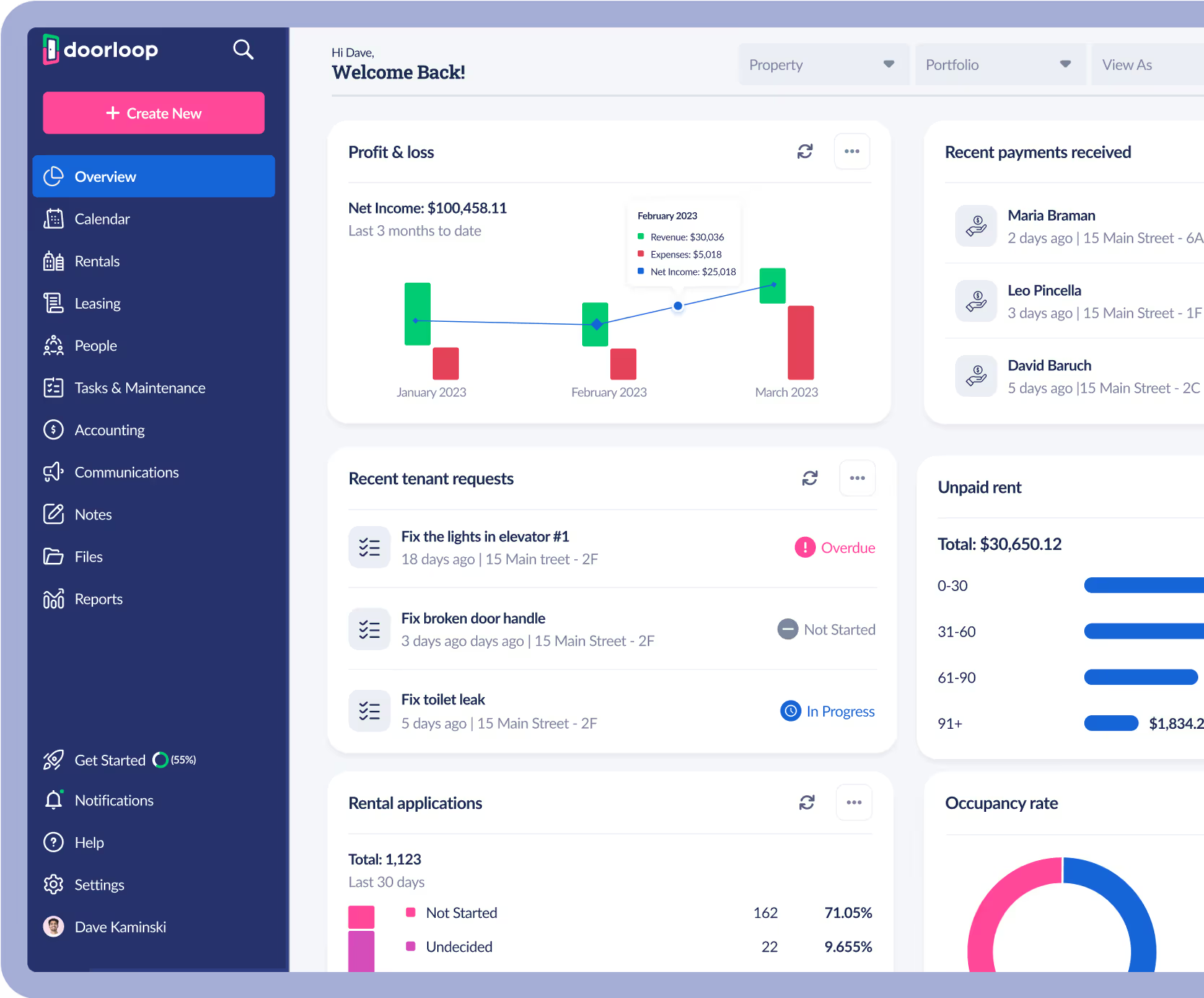Lease agreements are the cornerstone of any rental home, and ensuring that each new lease is drafted well and protects the rights of the owner and resident both is essential.
This comprehensive guide for landlords and property managers will provide you with valuable insights and tips on fixed-term and month-to-month leases, the lease agreement process, lease renewal management, and how to legally protect yourself and your property.
Follow this guide to ensure each newly signed lease puts you and your residents on track for a smooth lease term.
Understanding Different Lease Types
Leases define the legal relationship between a landlord and tenant. Whether you're dealing with a fixed-term or a month-to-month lease, it's crucial to understand the ins and outs of each type to ensure a smooth and legally compliant process and a good relationship with your tenant.
Different lease types come with their own benefits and legal aspects that can greatly impact both you and your tenants. Let's explore these two common lease types in more detail.
Fixed-Term Leases
Fixed-term leases are rental agreements where the tenant and landlord agree to rent a property for a specific period, usually one year. The rent amount remains unchanged during the term of the lease, and the lease can only be terminated before the end date if the tenant is in substantial breach of the lease or both parties mutually agree to it.
At the end of a fixed-term lease, the landlord can offer a lease renewal, allowing the current tenants to stay in the property. Alternatively, the lease can transition into a month-to-month lease, providing more flexibility for both parties thereafter.
When ending a lease, it's essential to give the required notice, which varies depending on the lease agreement and state laws.
Month-to-Month Leases
In contrast, month-to-month leases are rental agreements that don't have a set end date. These leases offer more flexibility for both landlords and tenants. Either party can terminate the lease at any time—provided that they give the required notice (typically 30 days).
However, this flexibility has a cost. If a tenant decides not to sign a lease agreement, they automatically fall under a month-to-month lease. In such cases, landlords may need to go through the eviction process to remove the tenant if they refuse to sign a new lease after proper notice has been given.
Moreover, month-to-month leases make for a more unstable or uncertain rental income. For this reason, to prepare for the risk, the monthly rent of these leases tends to be higher than those with a fixed period.
Preparing a New Lease Agreement: Step-by-Step
You've received a completed rental application, conducted a background check, determined that the applicants are good tenants and responsible, and decided you'd like them to be your new residents. Now it's time to prepare a contract for the rental.
Preparing a new lease agreement can be a daunting task, but it doesn't have to be. By researching your area's laws, including essential information, and using plain language, you can create a lease agreement that is clear, concise, and legally compliant.
To ensure a smooth process and a solid foundation for the landlord-tenant relationship, make sure to cover every aspect of the lease agreement, from the basic terms to the more intricate details. It's crucial to be thorough and diligent throughout the process to prevent potential disputes.
Research Local Laws
Before drafting a lease agreement, research your area's laws and regulations related to rental properties. Familiarize yourself with security deposit rules (e.g., maximum amount), eviction procedures, habitability standards, and other landlord-tenant laws that vary from state to state for a rental lease.
This will help you create a legally compliant lease agreement and protect you from legal issues that may arise during the tenancy. This will also give you a better understanding of your rights and responsibilities as a landlord.
Include Essential Information
Once you're familiar with laws of your area, start drafting the lease agreement.
A well-crafted lease agreement should include essential information like the names of the landlord and tenant(s), the property's address, the lease term, the rent amount, the security deposit, and any other relevant terms.
This information will ensure that both parties understand their rights and responsibilities under the lease and help prevent disputes.
Use Plain Language
When drafting a lease agreement, it's crucial to use plain language that is easy to understand. This will help both the landlord and tenant grasp the terms and conditions of the lease without any confusion.
Moreover, a clearly written lease agreement will be more likely to hold up in court if a dispute arises, providing additional legal protection for both parties.

Lease Signing and Move-In Procedures
Once the new lease is prepared, it's time to sign it and move in.
By reviewing the lease with tenants, collecting the security deposit and first month of rent, and conducting a property inspection and move-in checklist, you can ensure a smooth and successful start to the landlord-tenant relationship.
These steps will help protect your property and maintain a positive relationship with your tenants throughout the tenancy.
Review the Lease with Your Tenant
When the lease is ready, review it with your tenants to ensure they understand their rights and responsibilities. This allows you to go over all the important details, answer any questions they may have, and ensure they understand their rights and responsibilities.
Reviewing the lease with your tenants before the parties sign it also helps build a strong and trusting relationship, setting the stage for a successful tenancy during the rental lease term.
Collect the Security Deposit and First Month's Rent
Collecting the security deposit and first month's rent (and last month's rent, depending on your location) is a crucial step in the lease-signing process. The security deposit provides financial protection for the landlord in case of property damage or unpaid rent, while the first month of rent secures the tenant's commitment to the lease.
Make sure to follow your area's laws regarding security deposit amounts and procedures to ensure legal compliance.
Conduct a Move-In Property Inspection
Once you're done signing the contract and collecting any fees, deposits, or other pay from the tenants, you should conduct a property inspection in preparation for the move-in date.
Make and fill a move-in checklist to help make sure you don't miss anything during the inspection. Detail each appliance or other feature in each room. For example, list the condition of walls in the master bedroom and the walls in the kitchen separately.
This documents the property's condition at the start of the tenancy and helps protect you from disputes or legal issues related to property damage. It also sets a standard for the property's condition and care so that the landlord and the tenants living on the property are on the same page.
Make sure to address any necessary repairs or updates before the new tenant moves in to ensure a smooth and successful move-in.
With these steps completed, you're ready to welcome your new tenants and begin a successful landlord-tenant relationship!

Managing Lease Renewals and Transitions
Lease renewals and transitions are an important aspect of property management. Knowing when and how to offer a lease renewal, considering factors such as tenant behavior and rent increase, and preparing for tenant turnover are all crucial steps in maintaining a successful rental property.
By understanding the process and having a clear plan in place, landlords can ensure smooth lease transitions and maintain a positive relationship with your tenants.
Lease Renewal Considerations
When considering lease renewals, evaluate your tenants' behavior, including whether they are responsible, pay rent on time, stay on tip of utility bills, take care of the property, follow the rules discussed in their lease agreements, and respect neighbors.
This information will help you decide if it's in your best interest to offer a lease renewal or search for a new tenant.
If you decide to offer a lease renewal, it's common to raise the rent to cover your costs. However, be cautious not to raise it too much, as this can drive away good tenants. Also consider rent control laws in your area when doing so.
If you're considering a rent increase, send a written notice to your tenants before offering the lease renewal. This will give them time to decide whether to accept the increase or look for a new place to live.
Preparing for Tenant Turnover
If your existing tenant informs you of a move-out date and plan to move on, you'll have to find new tenants. During tenant turnover, you should take various steps to ensure a smooth move-out process, comply with the existing lease, and prepare the property for your next rental agreement.
Preparing for tenant turnover is a crucial aspect of property management. Begin by setting clear move-out guidelines for your tenants, such as ensuring the unit is clean, returning keys, and providing a forwarding address.
Additionally, conduct a final walk-through of the unit to ensure all repairs and updates have been completed before the new tenant moves in.
You should compare the notes of this move-out inspection with those of the move-in inspection to make sure your tenants are returning the property in good condition.
If there are any issues beyond normal wear and tear, you may need to see if you can take deductions from the security deposits too. That said, always be sure to check your area's laws and regulations before doing so.
To ensure a smooth transition between tenants, take the time to address any necessary repairs or updates before the new tenant moves in. This may include cleaning, painting, and fixing any damages. By preparing the unit for the new tenant, you'll create a positive first impression and set the stage for a successful landlord-tenant relationship.
Tips for Landlord and Property Manager Legal Protection
As a landlord or property manager, it's crucial to protect yourself and your property from potential legal issues. In this section, we'll discuss tips for handling rent payment disputes, property maintenance concerns, eviction procedures, and other lease disputes and challenges.
By staying informed and taking the necessary precautions, you can minimize the risk of legal problems and ensure a successful property management experience for your new lease or existing lease.
Rent Payment Disputes
If your current tenant does not pay rent by the due date designated in the existing lease, you can charge late fees.
That said, rent payment disputes can lead to serious legal consequences. To handle such disputes, keep track of all communication with tenants regarding rent payments and make sure you're familiar with your area's laws and regulations related to rent payment issues.
If necessary, be prepared to take legal action against tenants who fail to pay rent on time or in full.
Property Maintenance Concerns
Addressing property maintenance concerns is essential for maintaining a safe and habitable living space for your tenants. Document any maintenance issues and repairs, and keep track of all tenant interactions related to property maintenance.
You should also have a system in place so that your tenants can request maintenance when needed.
Familiarize yourself with your area's laws and regulations regarding tenant rights and landlord responsibilities, and ensure that you fulfill your obligations as a landlord.
Eviction Procedures
Eviction procedures can be complex and time-consuming. To avoid legal issues, ensure you're familiar with the eviction process and local laws governing the eviction of tenants.
If you need to evict a tenant, follow the proper procedures, including giving the required written notice, filing an eviction lawsuit, attending court, and executing a writ of possession. Consult with a lawyer if necessary to ensure compliance with all legal requirements.
Other Lease Disputes and Challenges
Other lease disputes and challenges, such as parking, noise, guests/subletters, pets, and more, can also lead to legal issues.
To protect yourself and your property, write your lease agreement to clearly state the rules and regulations related to these matters.
Keep track of all communication with tenants regarding disputes and challenges, and familiarize yourself with your area's laws and regulations related to these issues. By staying informed and proactive, you can minimize the risk of legal problems and maintain a successful rental property.
Additional Tips for Landlords and Property Managers
In addition to the tips we've covered so far, there are a few more essential pieces of advice to keep in mind when managing new leases.
By following these tips and staying proactive, you can ensure successful rental property management and maintain a positive landlord-tenant relationship.
The Four Essential Terms of a Lease
A lease should always include four essential terms: the tenant's name, the rental rate, the length of the lease, and the security deposit. Ensuring that these terms are clearly stated in the lease agreement will help prevent future disputes and provide a solid foundation for the landlord-tenant relationship.
By including these essential terms, you'll create a lease agreement that is legally binding and protects both parties' interests.
Most Important Clauses in a Lease
When drafting or reviewing a lease agreement, include or pay close attention to the following clauses:
- Severability
- Joint and several liability
- Right to entry
- Use of premises
- Rent due date and late fees
- Subletting
- Renewal and holdover
- Early termination
- Lease breakage
- Security deposit
There are many others worth looking at, but this list can get you started.
In general, these clauses establish the tenant's rights and responsibilities, the landlord's rights and responsibilities, and the rules and regulations of the property. They are vital for ensuring that both parties understand their obligations and the terms of the lease.
Common Mistakes to Avoid When Completing New Tenant Leases
The most common mistakes when writing a new lease agreement are failing to research local laws, include all essential information, use plain language, review the lease with tenants, collect security deposits and first month of rent, and prepare for tenant turnover.
Make sure to take care of all of these tasks with care, and you'll be set. Following these best practices will help you stay on the right side of the law and protect your property from potential legal issues.
The Importance of Communication and Documentation
Effective communication and documentation are paramount throughout the lease process. Maintaining open lines of communication with your tenants and keeping detailed records of all interactions will help prevent misunderstandings and potential disputes.
By fostering clear communication and thorough documentation, you can safeguard your legal interests, protect your property, and maintain a successful landlord-tenant relationship. Remember, a well-informed landlord is a successful landlord.
By staying proactive, informed, and diligent, you can minimize the risk of disputes, stay on good terms with your tenants, and enjoy a successful rental property management journey.
Online tenant portals are an excellent way to keep an open line of communication with your current tenant and allow you both to share and maintain important records.
Property management software like DoorLoop facilitates this by not only offering a tenant portal but also automating the performance and documentation of regular tasks like rent collection, maintenance requests, and more.
Frequently Asked Questions
Can my significant other live with me without being on the lease?
It's usually possible for your significant other to live with you without being on the lease. However, even if you have a new roommate who isn't officially listed as an additional tenant, it's wise to let your landlord know.
It's also important to ensure that both you and your partner understand the terms of such an arrangement and the rights that each party has in regard to it.
What type of lease is best for a landlord?
For landlords, the best type of lease is a fixed-term or long-term lease agreement that offers stability and minimizes turnover. These agreements can be tailored to both the tenant and landlord's needs and provide stability for the long run.
However, there are some benefits to using a month-to-month lease. Many landlords prefer the greater control over how long a tenant can live on their property or the flexibility to increase rent. They may have plans for selling the home or even moving in themselves as well.
In the end, the best type of lease agreements are the ones that suit your specific needs.
What are five things that should be included in a lease?
When creating a lease agreement, it's important to include key provisions like rent costs, tenant obligations, landlord obligations, security deposits, occupancy limits, pet policies, and the length of the tenancy. It's also beneficial to ensure that all parties involved fully understand the document they are signing.
A thorough lease helps protect both the tenant and landlord in the event of any disputes or misunderstandings.
































.svg)
.svg)

